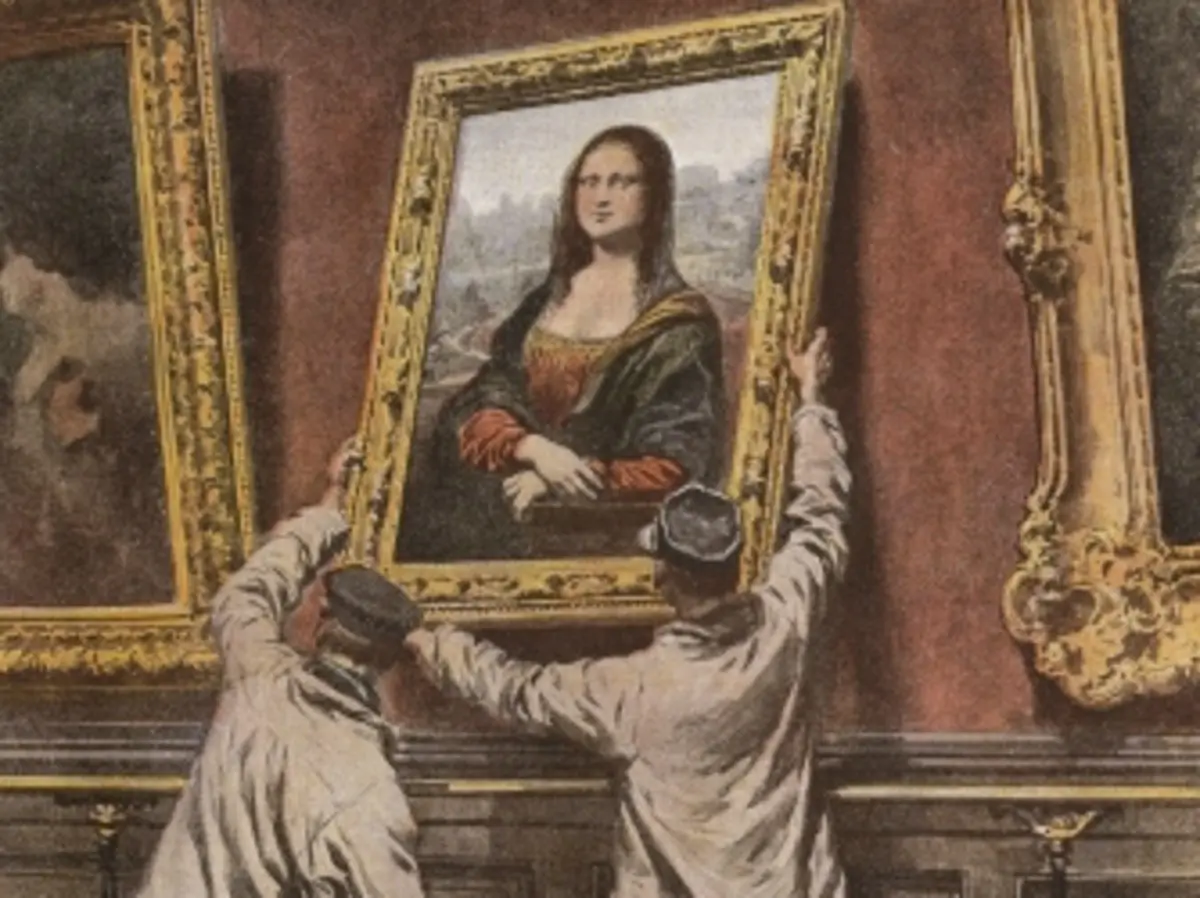
By The Italian Tribune
Leonardo da Vinci, Michelangelo, Botticelli and Caravaggio were each brilliant artists, but each also included unexpected features in some of their works. These secret messages and subtleties within their masterpieces went unrecognized for centuries, making the works of art even more astounding than what meets the eye.
A prime example is a scientific secret hiding in one of the most famous paintings of all time. It resides on the ceiling of the Sistine Chapel, painted by Michelangelo, as God gives Adam the first spark of life. Everyone has seen the image many times, but did you ever notice that the flowing reddish-brown cloak behind God and the angels is the exact shape of a human brain? Once you view the cloak next to an image of the brain, it is virtually impossible to look at the painting the same way again. Researchers have even been able to pick out certain parts, such as the vertebral artery, represented by an angel beneath God, as well as and the pituitary gland. There are multiple theories as to why Michelangelo might have done this; but most suggest that the brain represents God imparting divine knowledge to Adam.
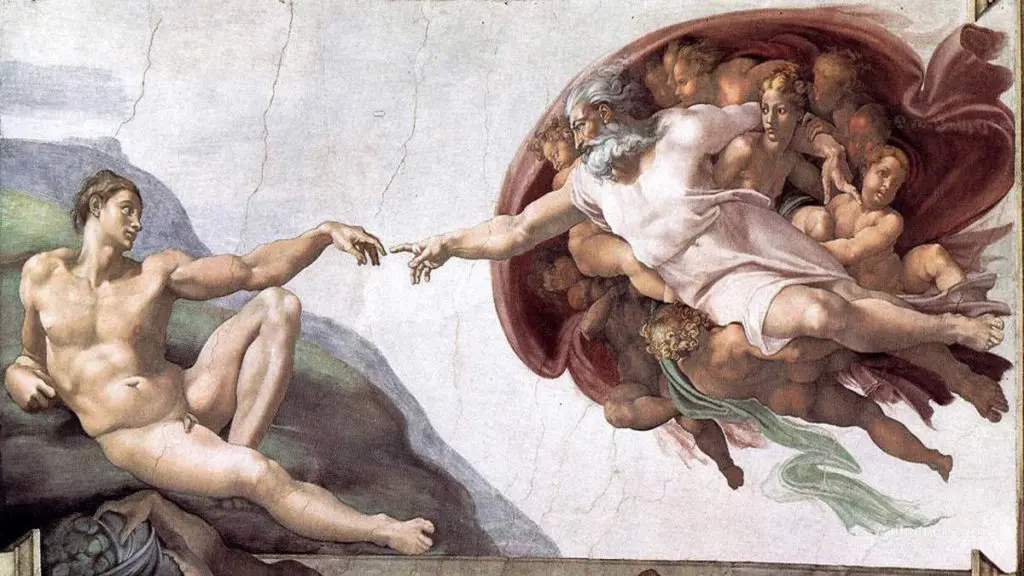
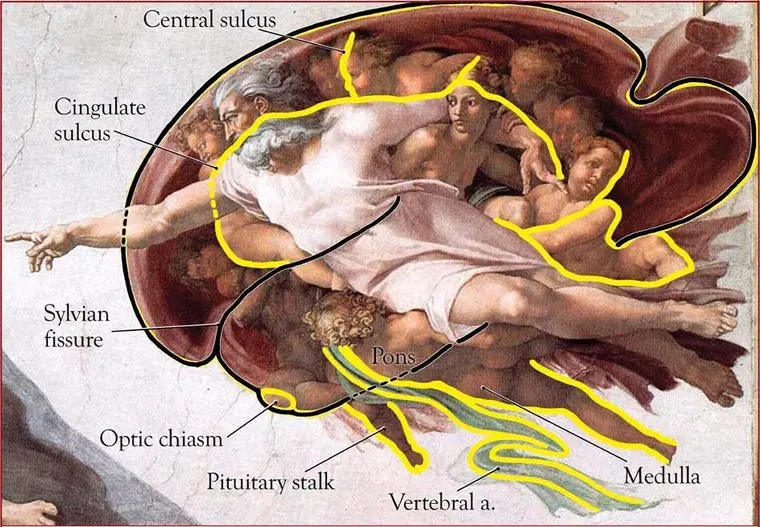
An angel with a bit of attitude can also be spotted on the Sistine Chapel ceiling. Pope Julius II, who commissioned the work, had many disagreements with Michelangelo, usually associated with the Pope denying payment to the artist. Michelangelo poked fun at his patron by painting the prophet Zechariah to look like Julius. That was neither a secret nor unusual at the time. Patrons of art works were often portrayed in the works they commissioned as onlookers, or even active participants in Biblical scenes. What was unusual about the Zechariah/Julius II was that one of the angels behind the figure is making a hand gesture called mano in fico. We now use it with children when we hold our thumb between two fingers while exclaiming “Got your nose,” but in the Renaissance it was used as a gesture of disgust when one felt that their request was inappropriately denied. Julius never noticed.
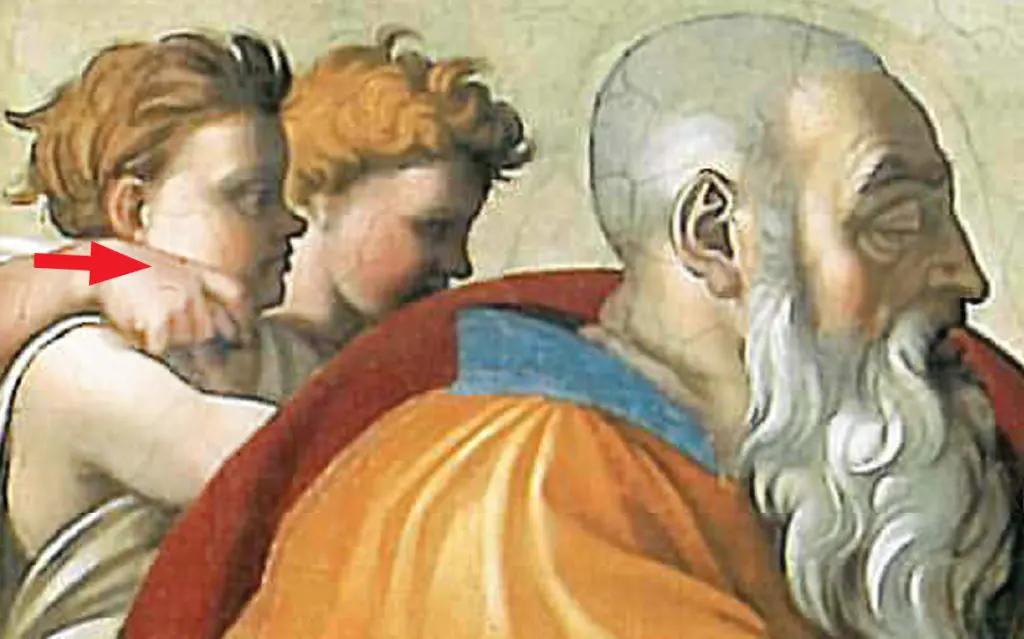
Another of the world’s most famous paintings is the Mona Lisa. Leonardo da Vinci painted his initials LV in her right eye. Even more surprising, in 2015, a scientist using reflective light technology claimed to have found another portrait of a woman underneath the image we see today. The consensus is that this was Leonardo’s “first draft” and that he painted over it to create his masterpiece. In addition to her hidden message, the Mona Lisa is also one of the most expensive items to ever have been stolen and remained missing for more than two years.
On August 21, 1911, 110 years ago, three men stole the Mona Lisa from the Louvre in Paris. After hiding in a closet all night, the men lifted 200 pounds of painting, frame and protective glass case off the wall. Stripped of its frame and case, the wooden panel was covered with a blanket as the men boarded a 7:47 am express train out of the city.
Before its theft, the Mona Lisa was not widely known outside the art world. Leonardo painted it in the early 16th century, but it was not until the 1860s that critics began to hail it as a masterwork of Renaissance painting. At the time of its theft, it was not even among the most widely known works of the museum, in fact, it was 28 hours before anyone noticed it was missing.
After the Louvre announced the theft, newspapers all over the world ran headlines about the missing masterpiece. The heist had become a national scandal. In France, there was a great deal of concern that American millionaires were buying up such masterpieces. At one point, American tycoon and art lover J.P. Morgan was suspected of commissioning the theft. Pablo Picasso was also considered a suspect and was questioned.
The three art thieves, brothers Vincenzo and Michele Lancelotti and their leader, Vincenzo Perugia, had brought the masterpiece back to Italy. Their intent was not entirely patriotic, but they intended to sell it to a wealthy Italian. With the notoriety associated with the heist, selling the work proved to be an impossible challenge. Twenty-eight months after he snatched it from the Louvre, Perugia finally tried to sell the painting to an art dealer in Florence. The dealer grew highly suspicious and alerted authorities, who arrested Perugia. With much fanfare, the painting was returned to the Louvre. Perugia pleaded guilty to stealing it and was sentenced to just eight months in prison. As a result of the theft, the Mona Lisa had become the most famous painting in the world and Perugia became a minor celebrity for bringing the painting back to Italy, if only for a short while.
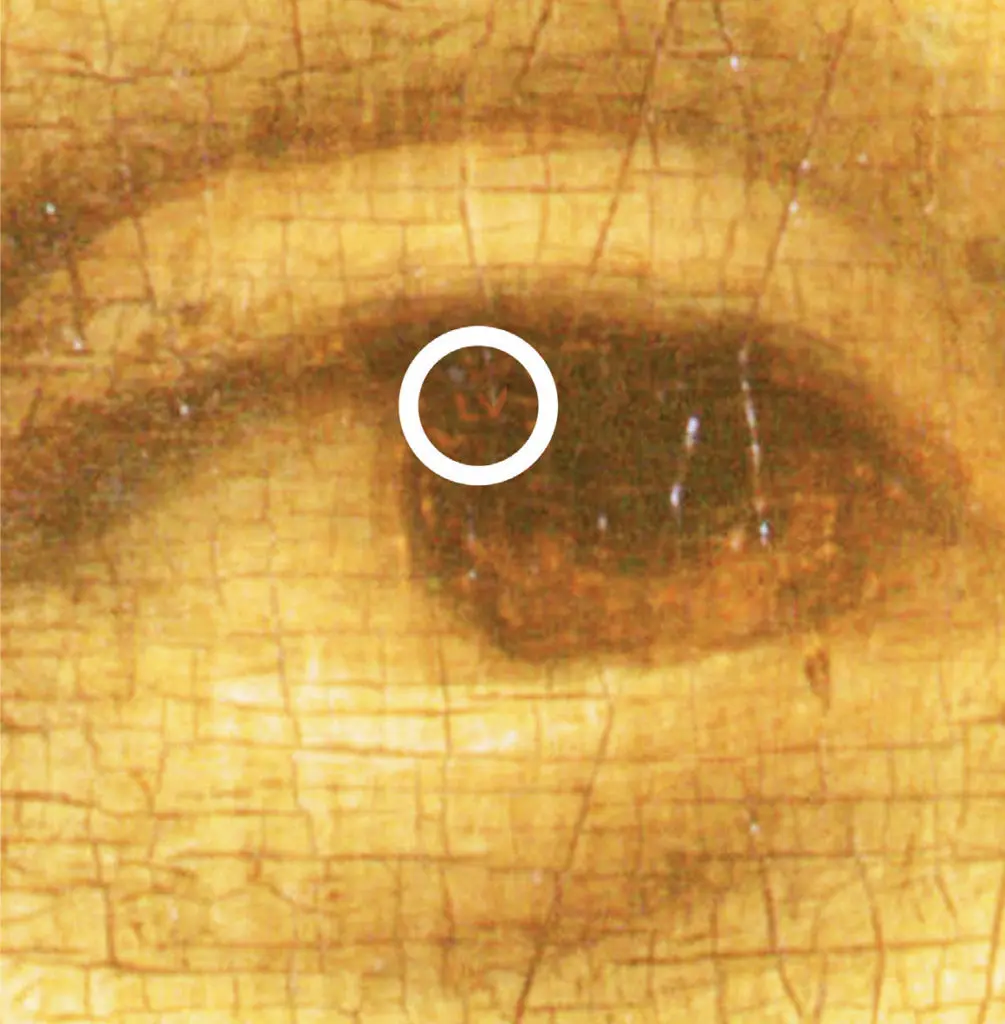
Sandro Botticelli was a friend of Leonardo and once operated an inn with the Renaissance genius. It was a flop, but Botticelli, who is best known for his painting, The Birth of Venus, also had quite the affinity for plants. In his masterpiece Primavera, circa 1480, there are six female figures, two males and a cupid in the allegorical work. But it is the number of plants that are contained in the painting that are truly outstanding. Although not as recognizable as The Birth of Venus, Primavera has long been one of the most studied paintings of the art world.
Measuring about seven feet high by ten feet wide, the tempura on panel can be found in the Uffizi Gallery in Florence. It was likely commissioned by a member of the Medici family and draws from a number of classical and Renaissance literary sources, including the works of the Ancient Roman poet Ovid. The painting is also believed to allude to a poem by Poliziano, the Medici house poet who may have helped Botticelli devise the composition. While most eyes are initially drawn to the figures, it is impossible to miss the great number of flowers and plants included throughout the painting. Botticelli painted the Italian flora with enough accuracy to make them recognizable to botanists and researchers have identified more than 500 different plant species in the painting, which include an astounding 190 different types of flowers.
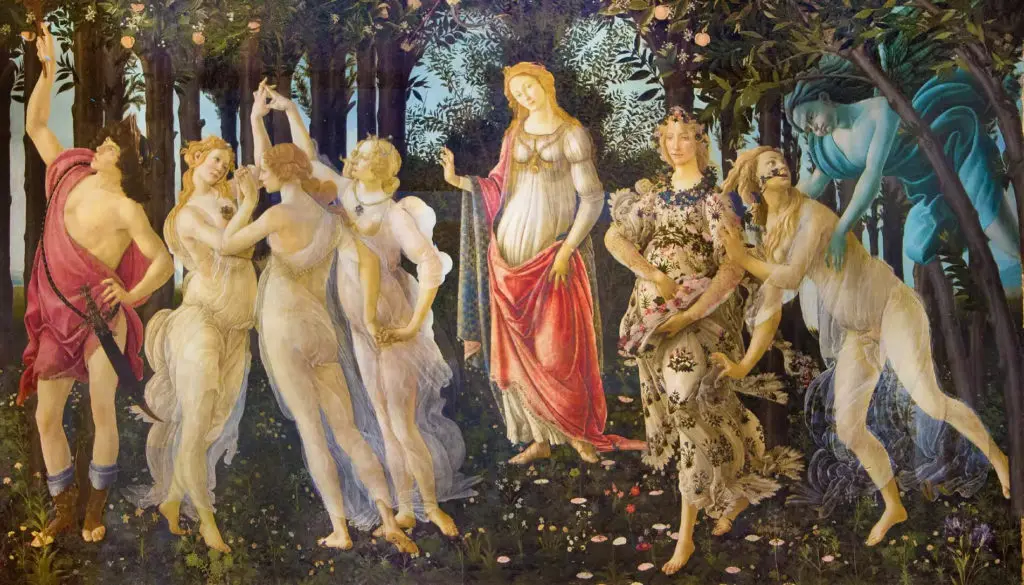
Another Italian Renaissance work from a few decades before Primavera has attracted more attention during the past 70 years, than it had for the previous five centuries. Domenico Ghirlandaio’s work “Madonna with Saint Giovannino” has an object to the right of the Blessed Virgin that some say looks like an unidentified flying object. While it may be compelling for extraterrestrial believers, a closer look reveals that there are a man and a dog looking up at the object. Sorry UFO enthusiasts, the man is a shepherd and image is a representation of a passage from the Gospel of Luke “Shepherds abiding in the field keeping watch over their flock by night. And lo, an angel of the Lord come upon them and the glory of the Lord shone round about them.”
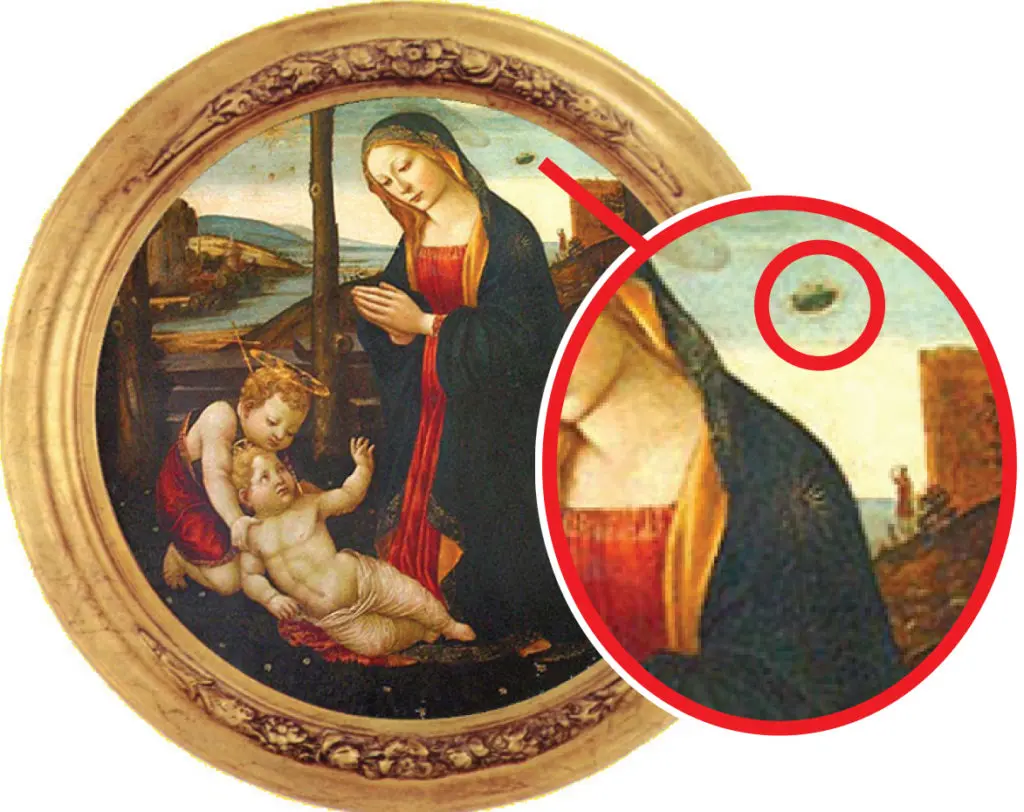
Finally there is Caravaggio painting in which he painted a portrait of the Roman god of wine, Bacchus, in 1595. It was not until a century ago that an art restorer recognized that after removing centuries of built up dirt, that the artist had included a small self-portrait in the work. In the glass wine jug in the bottom left-hand corner, a small image of Caravaggio sits in the tiny light reflection on the surface of the wine. Who knows how many other hidden and secret features lie hidden in plain sight by these and other Italian masters?
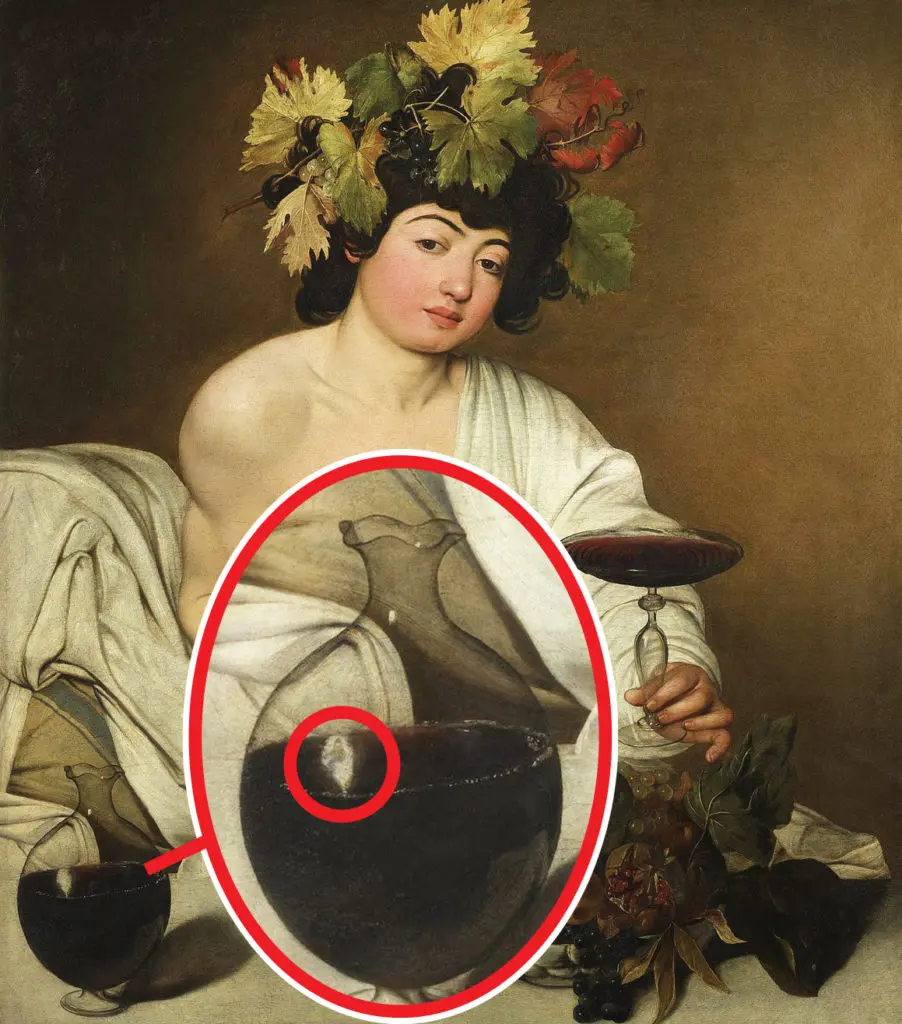
Source: The Italian Tribune





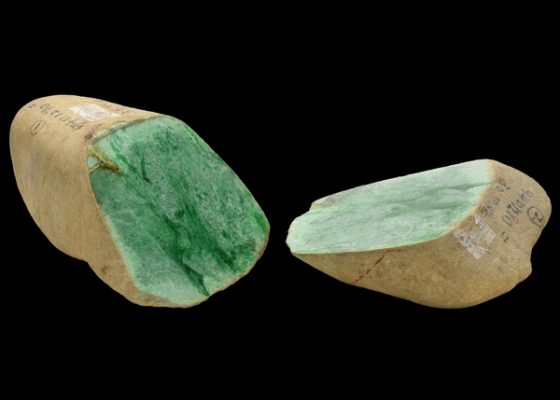
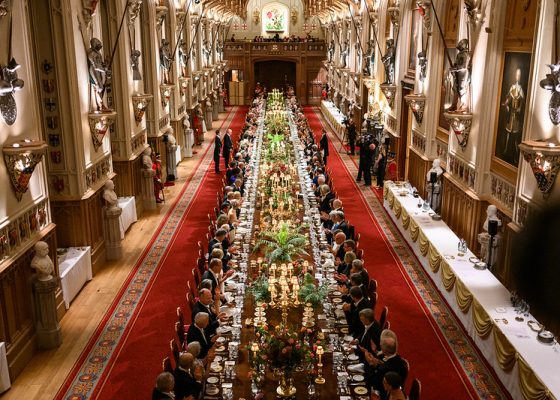


Cancel anytime


Using our website
You may use the The Middle Land website subject to the Terms and Conditions set out on this page. Visit this page regularly to check the latest Terms and Conditions. Access and use of this site constitutes your acceptance of the Terms and Conditions in-force at the time of use.
Intellectual property
Names, images and logos displayed on this site that identify The Middle Land are the intellectual property of New San Cai Inc. Copying any of this material is not permitted without prior written approval from the owner of the relevant intellectual property rights.
Requests for such approval should be directed to the competition committee.
Please provide details of your intended use of the relevant material and include your contact details including name, address, telephone number, fax number and email.
Linking policy
You do not have to ask permission to link directly to pages hosted on this website. However, we do not permit our pages to be loaded directly into frames on your website. Our pages must load into the user’s entire window.
The Middle Land is not responsible for the contents or reliability of any site to which it is hyperlinked and does not necessarily endorse the views expressed within them. Linking to or from this site should not be taken as endorsement of any kind. We cannot guarantee that these links will work all the time and have no control over the availability of the linked pages.
Submissions
All information, data, text, graphics or any other materials whatsoever uploaded or transmitted by you is your sole responsibility. This means that you are entirely responsible for all content you upload, post, email or otherwise transmit to the The Middle Land website.
Virus protection
We make every effort to check and test material at all stages of production. It is always recommended to run an anti-virus program on all material downloaded from the Internet. We cannot accept any responsibility for any loss, disruption or damage to your data or computer system, which may occur while using material derived from this website.
Disclaimer
The website is provided ‘as is’, without any representation or endorsement made, and without warranty of any kind whether express or implied.
Your use of any information or materials on this website is entirely at your own risk, for which we shall not be liable. It is your responsibility to ensure any products, services or information available through this website meet your specific requirements.
We do not warrant the operation of this site will be uninterrupted or error free, that defects will be corrected, or that this site or the server that makes it available are free of viruses or represent the full functionality, accuracy and reliability of the materials. In no event will we be liable for any loss or damage including, without limitation, loss of profits, indirect or consequential loss or damage, or any loss or damages whatsoever arising from the use, or loss of data, arising out of – or in connection with – the use of this website.
Last Updated: September 11, 2024
New San Cai Inc. (hereinafter “The Middle Land,” “we,” “us,” or “our”) owns and operates www.themiddleland.com, its affiliated websites and applications (our “Sites”), and provides related products, services, newsletters, and other offerings (together with the Sites, our “Services”) to art lovers and visitors around the world.
This Privacy Policy (the “Policy”) is intended to provide you with information on how we collect, use, and share your personal data. We process personal data from visitors of our Sites, users of our Services, readers or bloggers (collectively, “you” or “your”). Personal data is any information about you. This Policy also describes your choices regarding use, access, and correction of your personal information.
If after reading this Policy you have additional questions or would like further information, please email at middleland@protonmail.com.
PERSONAL DATA WE COLLECT AND HOW WE USE IT
We collect and process personal data only for lawful reasons, such as our legitimate business interests, your consent, or to fulfill our legal or contractual obligations.
Information You Provide to Us
Most of the information Join Talents collects is provided by you voluntarily while using our Services. We do not request highly sensitive data, such as health or medical information, racial or ethnic origin, political opinions, religious or philosophical beliefs, trade union membership, etc. and we ask that you refrain from sending us any such information.
Here are the types of personal data that you voluntarily provide to us:
As a registered users or customers, you may ask us to review or retrieve emails sent to your business. We will access these emails to provide these services for you.
We use the personal data you provide to us for the following business purposes:
Information Obtained from Third-Party Sources
We collect and publish biographical and other information about users, which we use to promote the articles and our bloggers who use our sites. If you provide personal information about others, or if others give us your information, we will only use that information for the specific reason for which it was provided.
Information We Collect by Automated Means
Log Files
The site uses your IP address to help diagnose server problems, and to administer our website. We use your IP addresses to analyze trends and gather broad demographic information for aggregate use.
Every time you access our Site, some data is temporarily stored and processed in a log file, such as your IP addresses, the browser types, the operating systems, the recalled page, or the date and time of the recall. This data is only evaluated for statistical purposes, such as to help us diagnose problems with our servers, to administer our sites, or to improve our Services.
Do Not Track
Your browser or device may include “Do Not Track” functionality. Our information collection and disclosure practices, and the choices that we provide to customers, will continue to operate as described in this Privacy Policy, whether or not a “Do Not Track” signal is received.
HOW WE SHARE YOUR INFORMATION
We may share your personal data with third parties only in the ways that are described in this Privacy Policy. We do not sell, rent, or lease your personal data to third parties, and We does not transfer your personal data to third parties for their direct marketing purposes.
We may share your personal data with third parties as follows:
There may be other instances where we share your personal data with third parties based on your consent.
HOW WE STORE AND SECURE YOUR INFORMATION
We retain your information for as long as your account is active or as needed to provide you Services. If you wish to cancel your account, please contact us middleland@protonmail.com. We will retain and use your personal data as necessary to comply with legal obligations, resolve disputes, and enforce our agreements.
All you and our data are stored in the server in the United States, we do not sales or transfer your personal data to the third party. All information you provide is stored on a secure server, and we generally accepted industry standards to protect the personal data we process both during transmission and once received.
YOUR RIGHTS/OPT OUT
You may correct, update, amend, delete/remove, or deactivate your account and personal data by making the change on your Blog on www.themiddleland.com or by emailing middleland@protonmail.com. We will respond to your request within a reasonable timeframe.
You may choose to stop receiving Join Talents newsletters or marketing emails at any time by following the unsubscribe instructions included in those communications, or you can email us at middleland@protonmail.com
LINKS TO OTHER WEBSITES
The Middle Land include links to other websites whose privacy practices may differ from that of ours. If you submit personal data to any of those sites, your information is governed by their privacy statements. We encourage you to carefully read the Privacy Policy of any website you visit.
NOTE TO PARENTS OR GUARDIANS
Our Services are not intended for use by children, and we do not knowingly or intentionally solicit data from or market to children under the age of 18. We reserve the right to delete the child’s information and the child’s registration on the Sites.
PRIVACY POLICY CHANGES
We may update this Privacy Policy to reflect changes to our personal data processing practices. If any material changes are made, we will notify you on the Sites prior to the change becoming effective. You are encouraged to periodically review this Policy.
HOW TO CONTACT US
If you have any questions about our Privacy Policy, please email middleland@protonmail.com
The Michelin brothers created the guide, which included information like maps, car mechanics listings, hotels and petrol stations across France to spur demand.
The guide began to award stars to fine dining restaurants in 1926.
At first, they offered just one star, the concept was expanded in 1931 to include one, two and three stars. One star establishments represent a “very good restaurant in its category”. Two honour “excellent cooking, worth a detour” and three reward “exceptional cuisine, worth a
Thank you for your participation,
please Log in or Sign up to Vote

123Sign in to your account